Real-world tests reveal top 5G carriers in major US cities: how does yours fare?
RootMetrics takes a look at current 5G performance across Chicago, Dallas, Indianapolis, Los Angeles, and Washington, D.C.
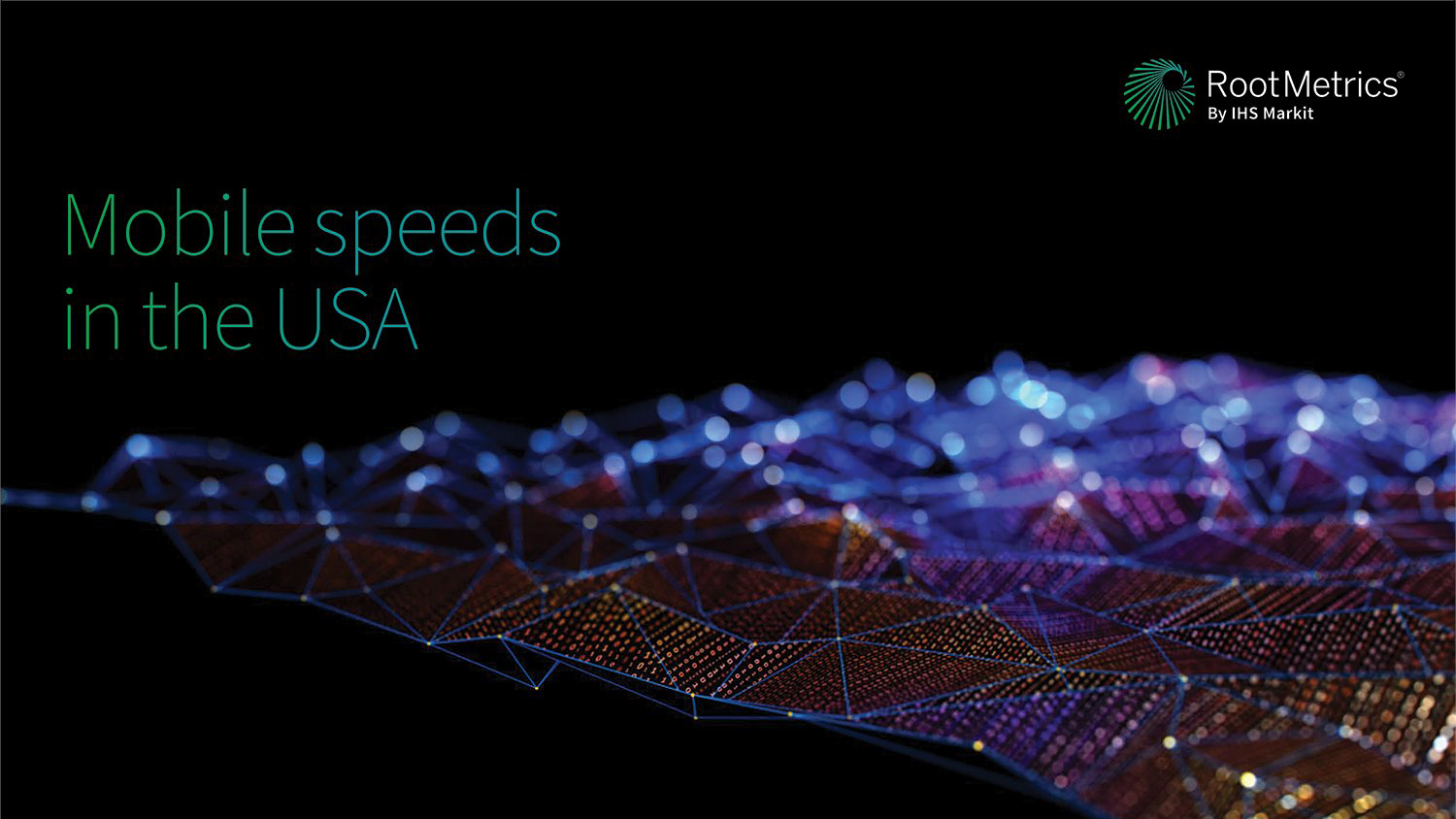
5G technology is slowly spreading throughout the US, and RootMetrics recently gave the new network a real-world test across five major cities to cities to see how the newly deployed low-band 5G networks of AT&T 5G and T-Mobile 5G compared to the mid-band 5G network of Sprint and Verizon’s millimeter wave 5G.
RootMetrics tested real-world 5G across Chicago, Dallas, Indianapolis, Los Angeles, and Washington, D.C. The results showed that while 5G is still maturing in the US, the new network is clearly capable of providing much faster speeds than current 4G LTE networks can support and in some cities the recorded speeds are already truly dazzling.
5G speed & coverage in Chicago
Sprint 5G and Verizon 5G deliver impressive speeds in Chicago, while T-Mobile offers the most 5G.
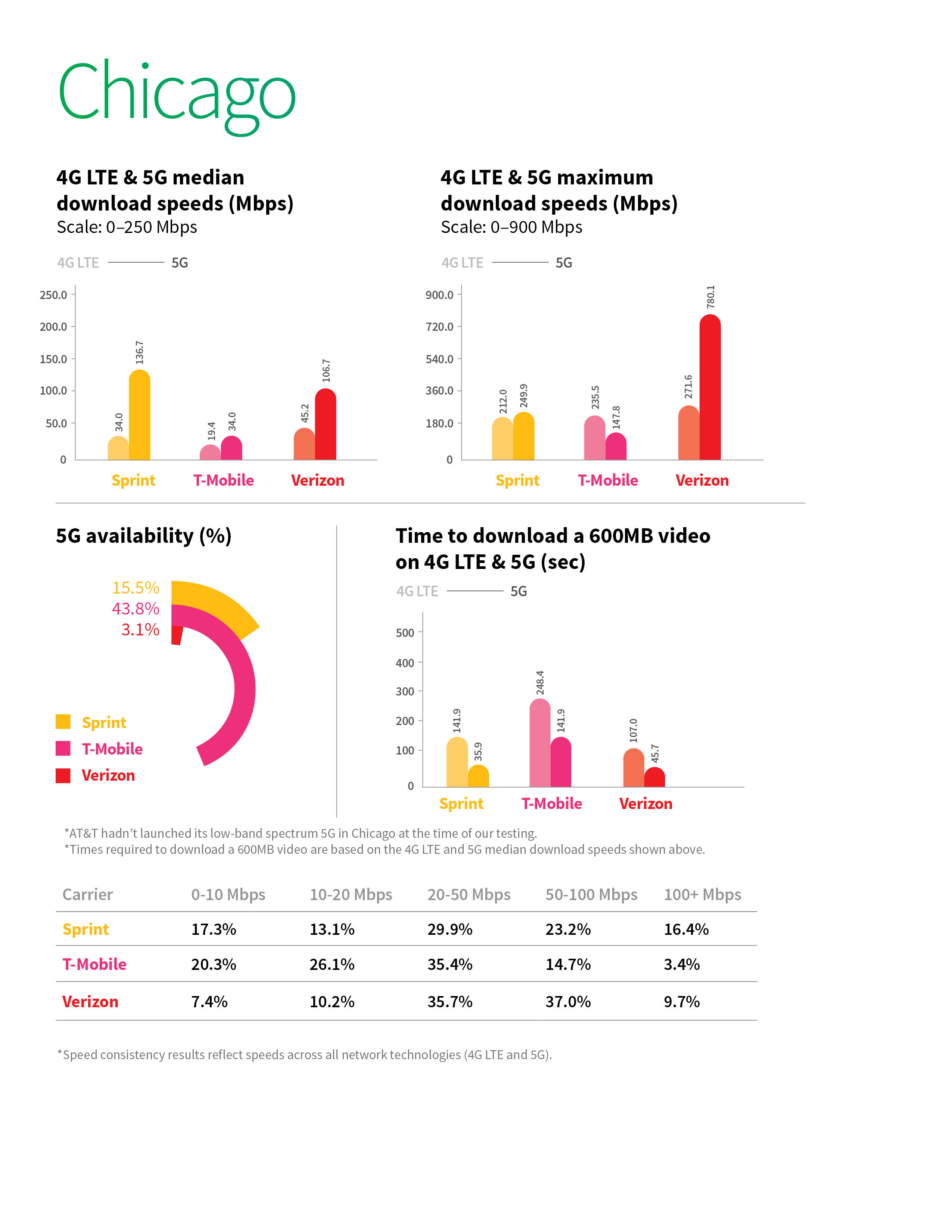
Sprint’s mid-band spectrum 5G network proved to be the fastest in Chicago, delivering a blazing-fast 5G median download speed of 136.7 Mbps. Verizon was hot on Sprint’s heels with a 5G median download speed of 106.7 Mbps.
T-Mobile’s 5G wasn’t nearly as fast as either Sprint or Verizon, with a 5G median download speed of 34.0. However, T-Mobile offers the most 5G in Chicago with 43.8% of the tests recorded on T-Mobile’s 600 MHz 5G.
"Verizon customers should be pleased with the carrier’s mmWave 5G"
RootMetrics
Verizon’s mmWave 5G came out very well in the test. “With maximum download speeds offering a look at a network’s potential, Verizon customers should be pleased with the carrier’s mmWave 5G,” stated the report. Indeed, Verizon’s 5G maximum download speed of 780.1 Mbps ranked among the three fastest 5G maximum download speeds the company recorded in the US to date, with Verizon also delivering the other two.
5G carrier consistency in Chicago
In Chicago, Sprint and Verizon showed impressive speed consistency results, with both carriers clocking speeds of at least 50 Mbps (and 100 Mbps) far more often than T-Mobile.
Get up to speed with 5G, and discover the latest deals, news, and insight!
T-Mobile delivered topline speeds of 100 Mbps or faster during 3.4% of the tests and speeds of at least 50 Mbps over 18% of the time. The company also registered speeds between 0 – 20 Mbps a little over 46% of the time, easily the highest rate among all three carriers in Chicago.
“Verizon’s consistency of delivering fast speeds was unmatched”
RootMetrics
Looking at the lower end of the speed intervals, Verizon registered speeds below 10Mbps just 7.4% of the time and while Sprint delivered high-end speeds of least 100 Mbps nearly twice as often as Verizon, Sprint also registered speeds in the 0-10 Mbps and 10-20 Mbps ranges at higher rates than that of Verizon. ‘While both Sprint and Verizon were fast in Chicago, Verizon’s consistency of delivering fast speeds was unmatched,” stated RootMetrics.
5G speed & coverage in Indianapolis
In Indianapolis, AT&T’s 5G races past T-Mobile’s, but T-Mobile offers the most 5G coverage.
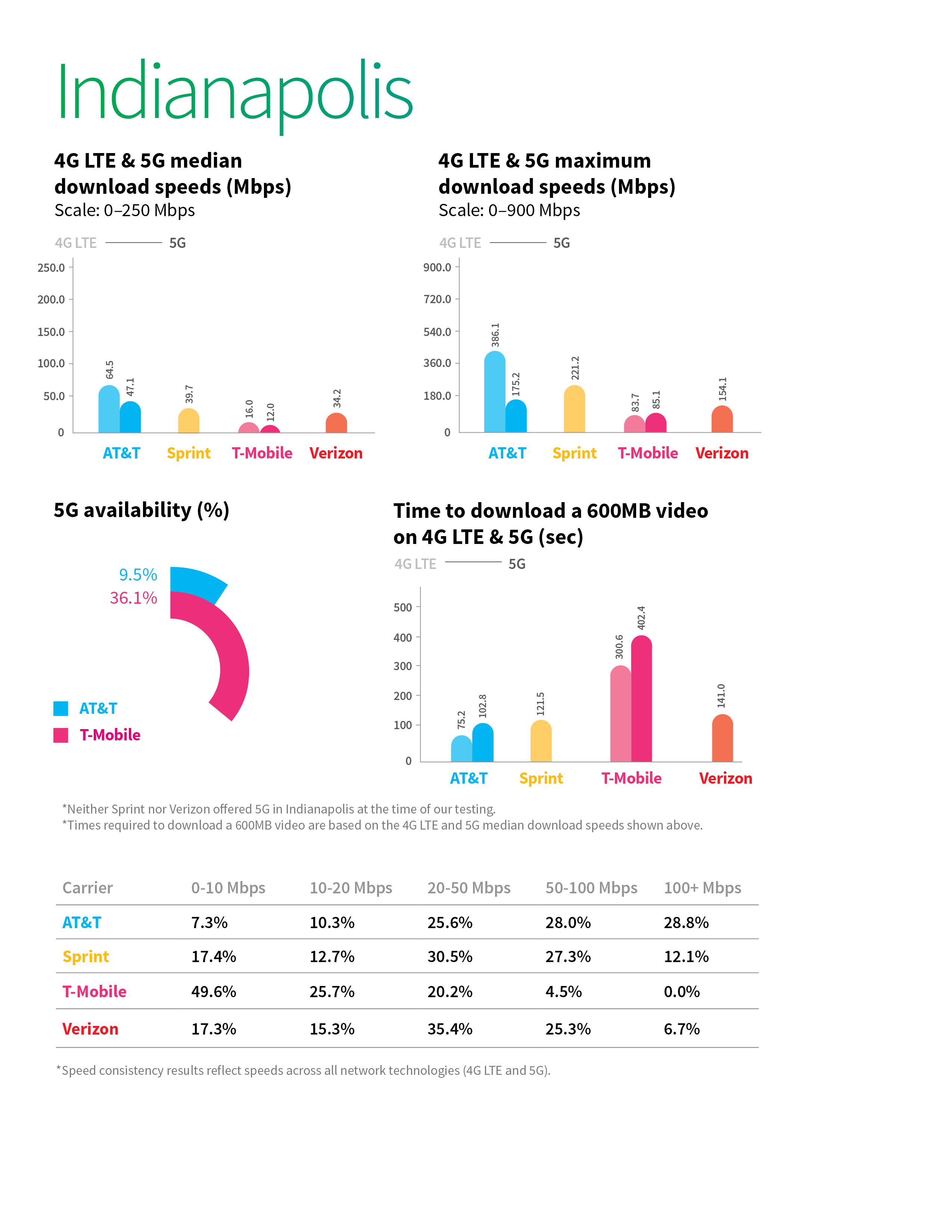
Neither Sprint nor Verizon offered 5G in Indianapolis at the time of RootMetrics testing, so the competition is currently between AT&T and T-Mobile. T-Mobile had more widespread 5G availability than AT&T across the city – AT&T actually showed a relatively low 5G availability of 9.5% in Indianapolis.
“T-Mobile’s 5G speed in Indianapolis and remained fast enough to handle most typical end-user behaviours”
RootMetrics
AT&T’s 5G speed proved to be solid but its 4G LTE was even faster. “While AT&T’s 5G median download speed of 47.1 Mbps wasn’t as fast as some of the 5G speeds recorded across the five cities we visited, that speed was still nearly four times faster than T-Mobile’s 5G speed in Indianapolis and remained fast enough to handle most typical end-user behaviours,” stated RootMetrics.
AT&T continued its trend of delivering fast 4G LTE speeds in major US cities, clocking an impressive 4G LTE speed of 64.5 Mbps. AT&T showed a 5G median download speed approaching 50 Mbps, so the end-user speed should be smooth and that even when 5G isn’t available, thanks to the strong 4G LTE network performance.
Disappointingly, T-Mobile’s 5G speeds lagged behind the 4G LTE speeds of other carriers: T-Mobile’s 5G median download speed of 12.0 Mbps was the carrier’s slowest 5G speed across all five cities tested, and it was also slower than the 4G LTE speeds of the other carriers. T-Mobile’s 4G LTE speed was actually faster than its 5G speed.
5G carrier consistency in Indianapolis
AT&T’s consistency of delivering game-changing speeds in Indianapolis was excellent. AT&T’s 5G median download speed in Indianapolis was 47.1 Mbps and the carrier’s speed results across 4G LTE and 5G showed that the carrier delivered speeds of at least 100 Mbps nearly 30% of the time, with speeds of 50 Mbps or better recorded during roughly 57% of the tests.
"AT&T also impressed at the lower end of the spectrum”
RootMetrics
“AT&T also impressed at the lower end of the spectrum, registering speeds between 0-10 Mbps and 10-20 Mbps during less than 18% of our tests, easily the lowest rate among all carriers,” stated RootMetrics.
Although neither Sprint offered 5G at the time of testing, both showed strong results. Sprint delivered download speeds of at least 50 Mbps during nearly 40% of tests, with speeds over 100 Mbps recorded 12.1% of the time.
Verizon delivered download speeds between 50 - 100 Mbps 25.3% of the time and speeds of at least 100 Mbps during 6.7% of our tests. T-Mobile was much slower, recording download speeds below 10 Mbps during nearly 50% of tests, with no speeds of 100 Mbps or better.
5G speed & coverage in Dallas
Sprint offers highest speed and availability across Dallas
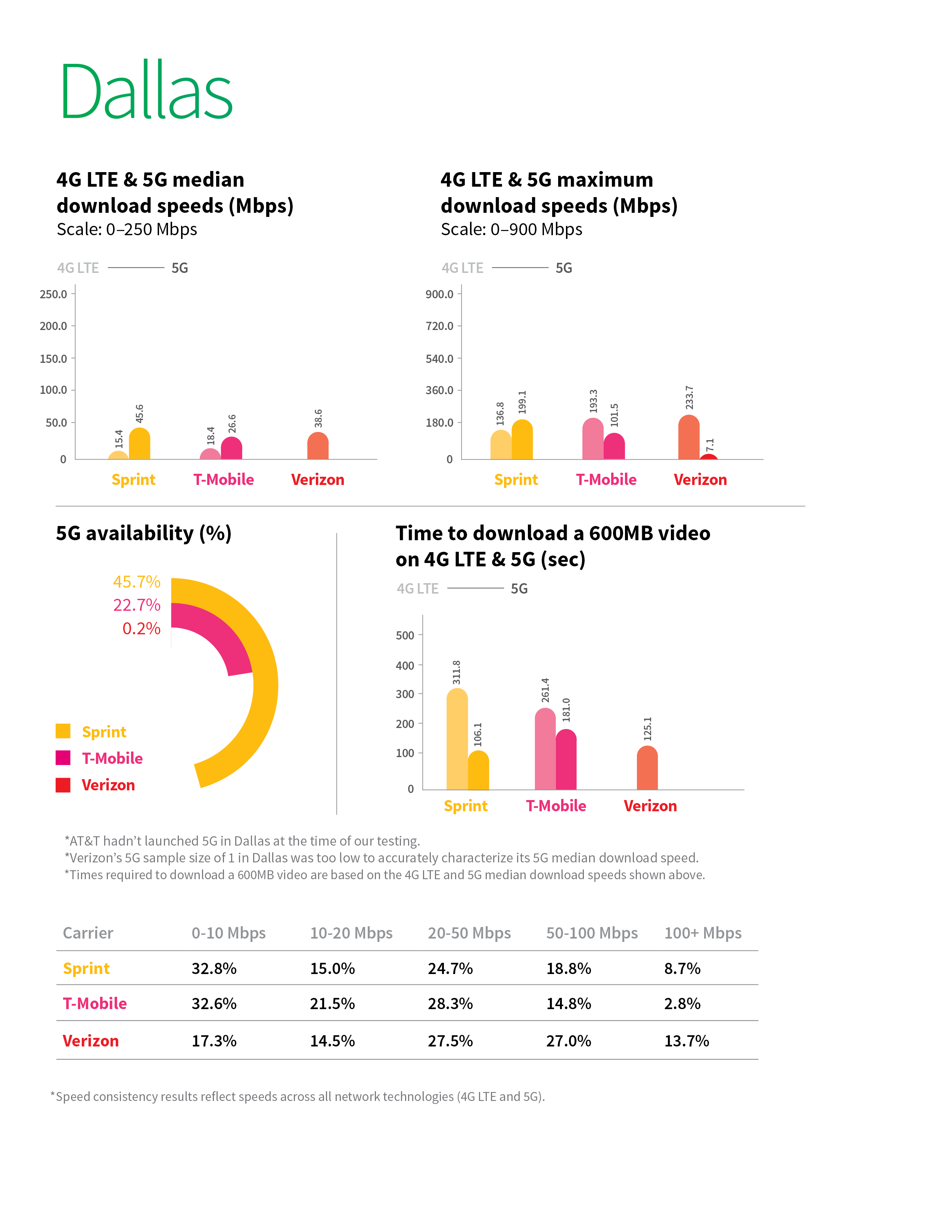
Sprint offered both the highest 5G availability rate among all carriers and its 5G median download speed was much faster than that of T-Mobile. AT&T hadn’t launched 5G in Dallas at the time of testing and Verizon’s 5G sample size of 1 in Dallas was too low for RootMetrics to accurately test.
Sprint’s 5G median download speed of 45.6 Mbps was the fastest in Dallas and almost three times faster than its 4G LTE speed. While T-Mobile’s 5G median download speed of 26.6 Mbps was slower than that of Sprint, it was quite a bit faster than T-Mobile’s 4G LTE median download speed of 18.4 Mbps.
T-Mobile’s 5G coverage proved to be relatively strong with availability of 22.7% in Dallas, especially given the early stage of the carrier’s 5G deployment.
"“the 5G speeds of Sprint and T-Mobile were somewhat uninspiring”
RootMetrics
“Sprint and T-Mobile offer mixed speed results: While we weren’t able to collect enough test samples to accurately characterize Verizon’s 5G median download speed in Dallas, the 5G speeds of Sprint and T-Mobile were somewhat uninspiring,” stated RootMetrics.
5G Carrier consistency in Dallas
The most important part of the end-user experience revolves around 5G speeds, so, in that regard, Verizon shone in Dallas, despite the carrier’s 5G availability being the lowest and RootMetrics not collecting enough 5G samples to accurately characterise its 5G median download speed.
Verizon was consistently fast, registering download speeds of at least 100 Mbps during 13.7% of tests and speeds over 50 Mbps roughly 40% of the time. Neither Sprint nor T-Mobile came close to delivering fast speeds as often as Verizon.
5G speed & coverage in Los Angeles
Sprint and Verizon both prove to strong options in LA.
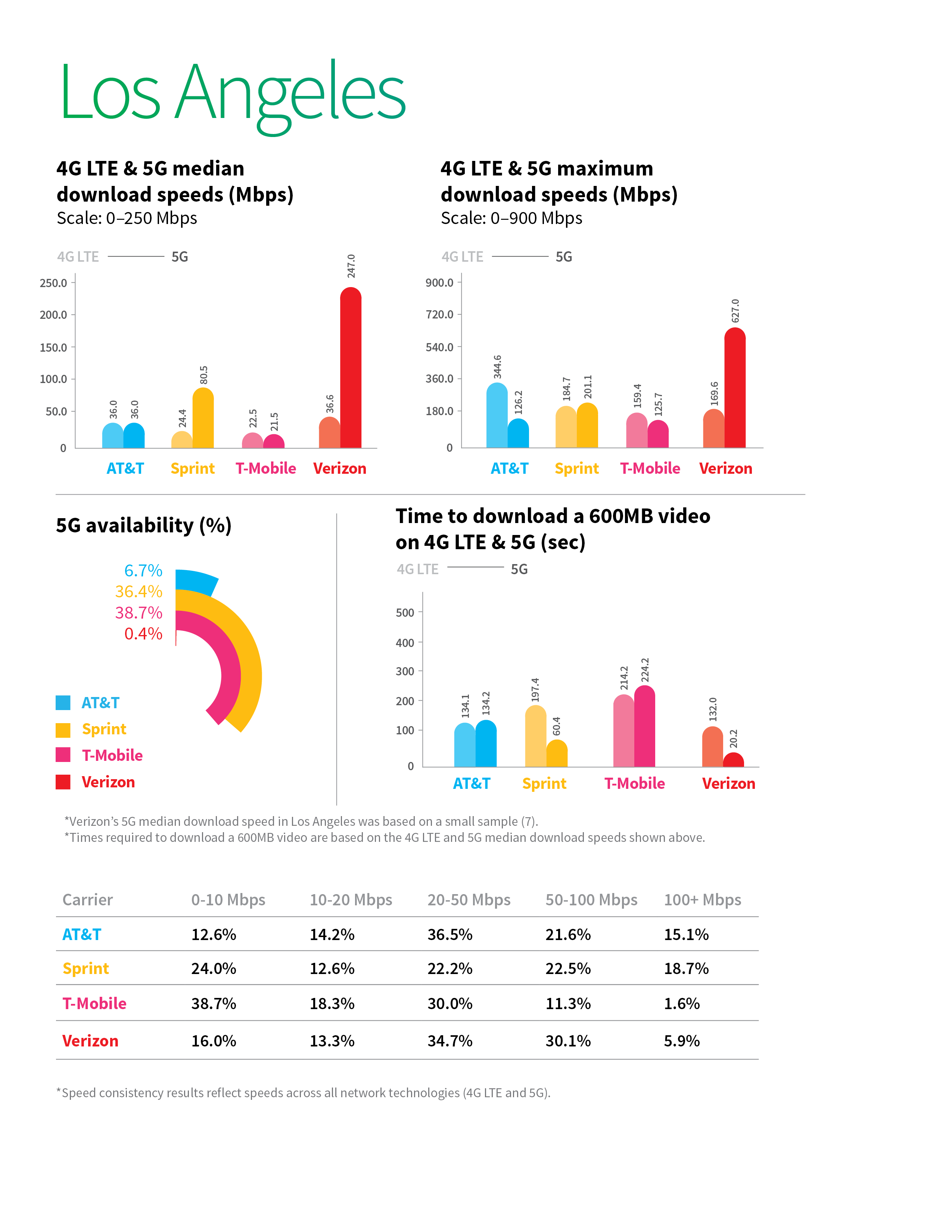
RootMetrics tests found 5G availability mixed in LA – Sprint and T-Mobile offered 5G on a relatively broad scale, while that of AT&T and Verizon’s was quite low. However, AT&T’s 5G speeds were much faster than those of T-Mobile.
“fastest 5G median download speed we’ve recorded in the US to date”
RootMetrics
Sprint’s 5G median download speed of 80.5 Mbps in LA was impressive although beaten by Verizon’s blazing fast 5G median download speed of 247.0 Mbps. “Not only the fastest 5G median download speed we’ve recorded in the US to date, it was also faster than the 5G maximum download speeds of all other carriers in LA,” commented RootMetrics.
It’s worth noting however that Verizon’s 5G availability of just 0.4% in LA means customers will experience its blazing-fast speeds in only certain parts of the city, but its 4G LTE network still offers decent speed.
5G Carrier consistency in LA
AT&T’s and Sprint’s speed consistency results were particularly strong in Los Angeles, with both registering download speeds of 100 Mbps or faster during at least 15.1% of tests, with speeds of at least 50 Mbps recorded over 36% of the time.
Verizon’s targeted 5G strategy focuses its 5G to certain areas of LA, but the carrier continued to deliver strong speeds on its 4G LTE network, with the majority of download speeds falling in the 20-50 Mbps and 50-100 Mbps ranges.
T-Mobile registered download speeds below 10 Mbps during 38.7% of tests and the company also had the fewest tests recorded with speeds of at least 100 Mbps – just 1.6% of the time.
5G speed & coverage in Washington, D.C.
Sprint provides excellent 5G results across all categories in Washington, while Verizon’s maximum download speed dazzles.
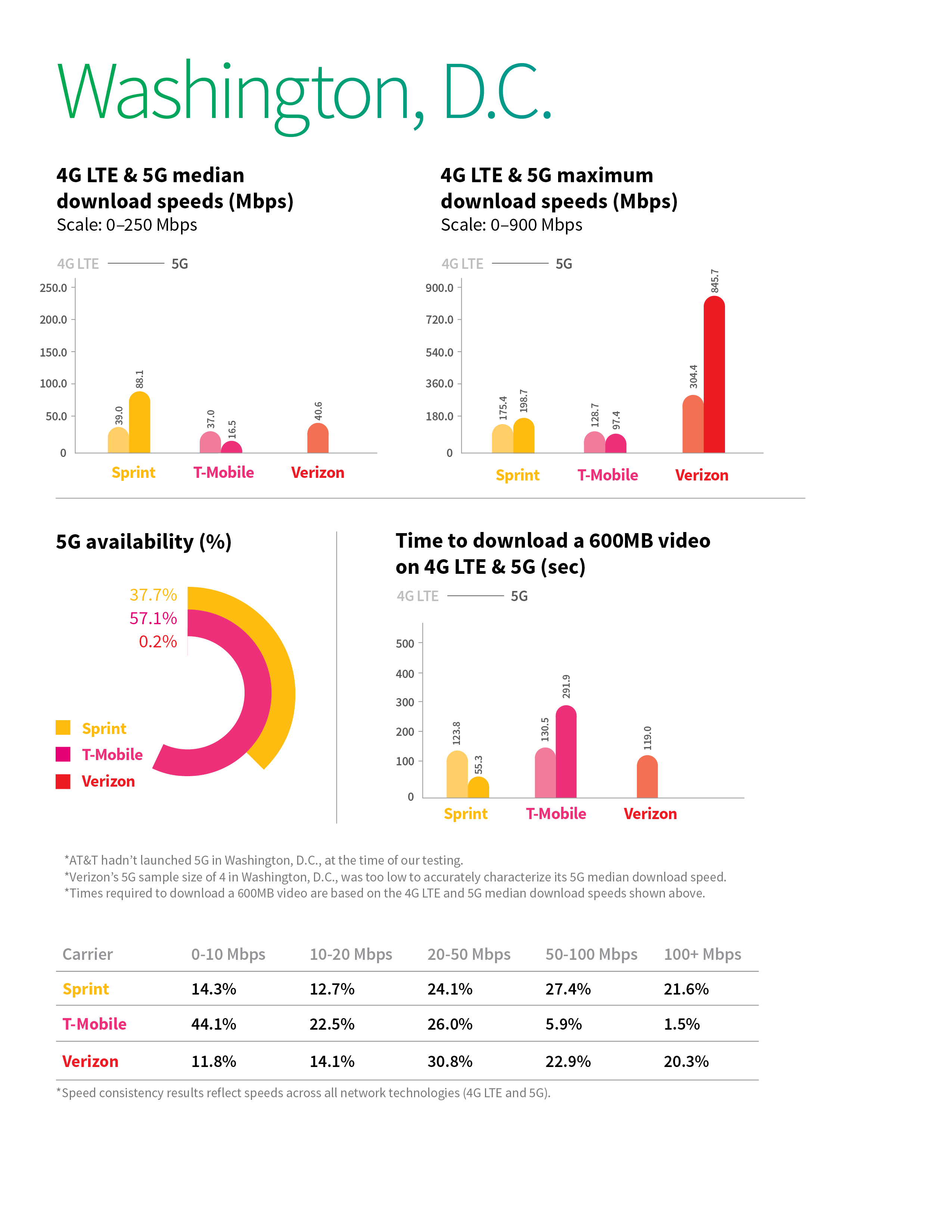
Sprint clocked in an excellent 88.1 Mbps in Washington, D.C. – its second-fastest 5G median download speed across all five cities tested. Sprint’s mid-band spectrum 5G network also had relatively broad 5G availability of 37.7) and a 5G speed that was over twice as fast as its 4G LTE speed. Sprint’s 5G median download speed was over five times faster than that of T-Mobile.
Verizon’s mmWave 5G delivers a remarkable maximum download speed of 845.7 Mbps. RootMetrics didn’t deliver enough test samples to accurately score Verizon’s 5G median download speed, but the maximum download speed suggests customers won’t be disappointed going forward.
Disappointingly, not only did T-Mobile’s 5G median download speed trail those of the other carriers in the capital, its 4G LTE was over twice as fast as its 5G in the capital too.
AT&T hadn’t launched in the capital at the time of testing.
5G Carrier consistency in Washington, D.C.
Sprint and Verizon both provided strong speeds in Washington, D.C., clocking download speeds of 100 Mbps or better over 20% of the time during testing. Sprint registered speeds of 50 Mbps or faster nearly 50% of the time, while Verizon delivered speeds of at least 50 Mbps during roughly 43% of tests.
“The 5G speeds we did record on Verizon’s network were extremely fast.”
RootMetrics
“While we didn’t collect enough 5G test samples to characterize Verizon’s 5G median download speed, the bottom line is that Verizon’s 4G LTE download speeds were strong, and the 5G speeds we did record on Verizon’s network were extremely fast,” commented RootMetrics.
While T-Mobile’s 5G availability rate of 57.1% was easily the highest in the city, the carrier delivered speeds of 100 Mbps or better during just 1.5% of tests - considerably lower than those of either Sprint or Verizon.
At the slower end of the speed spectrum, 44.1% of T-Mobile’s speeds fell between 0-10 Mbps, whereas Sprint and Verizon had speeds in that range less than 14.3% of the time.
5G game changer
While early 5G speeds in the US are somewhat mixed, it’s great to see some carriers already providing extremely impressive speeds on 5G and already surpassing those on 4G LTE.
“Verizon’s mmWave 5G could be a game changer for the end user connected experience, with its median and maximum 5G speeds currently showing much more potential than what we’ve seen with low and mid-band 5G,” commented RootMetrics, who expect to see faster 5G speeds as we move further into 2020 and beyond.
"“There are more and more 5G-enabled devices on the market and the Samsung S20 will help boost usage in the near term”
Kevin Hasley, RootMetrics
Speaking to 5Gradar about how the company expect their findings to change by next year, Kevin Hasley, Chief Commercial Officer of RootMetrics said: “The networks are already delivering services that meet the needs of most consumers. But we expect to see 5G availability and speeds continue to increase throughout the year and that trend to continue in 2021 as well. Dynamic Spectrum Sharing (DSS) is expected to take hold later in 2020 and will allow 5G and LTE to share the same spectrum, making networks more flexible. Dynamic Spectrum Sharing (DSS) is expected to take hold later in 2020 and will allow 5G and LTE to share the same spectrum, making networks more flexible. There are more and more 5G-enabled devices on the market and the Samsung S20 will help boost usage in the near term. Longer term, if the new iPhone supports 5G as expected, we’ll see a huge boost in 5G adoption by consumers. We’ll continue to test 5G throughout the year to give an objective look at where each of the networks stands.”
Rachael is a British journalist with 17 years experience in the publishing industry. Since launching www.digitalcameraworld.com, she’s been freelancing, and working for some of the world’s best-loved websites and magazines including T3.com and TechRadar.com and has also had a book, iPad for Photographers, published. A regular contributor at 5Gradar, Rachael is following the 5G market closely. Find out more at www.rachaelsharpe.com

